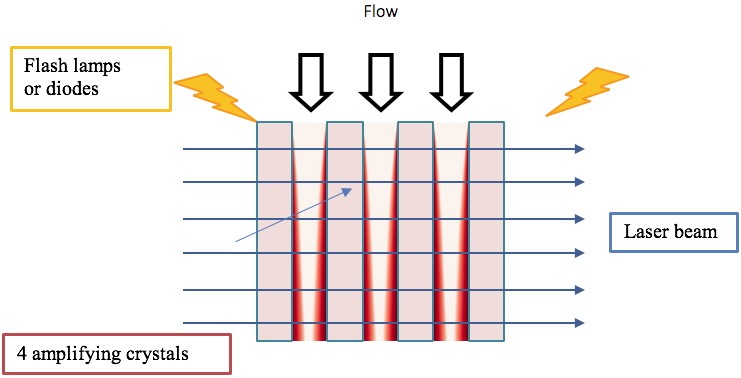Summary:
The field of High Power Lasers has experienced huge progress over the past years, and is still a very active domain. Indeed, the discovery by Gérard Mourou and Donna Strickland (Nobel Prize 2018) of the CPA technique has enabled a very fast increase of the power of lasers. Many PW (petawatt) or even multi-PW lasers are now in operation today or under commissioning in Europe (CLPU in Salamanca, ELI project in three eastern European countries, Apollon in France). Moreover, this rapid progress in power has been accompanied by a fast progress in the repetition rate (1 short laser shot every two hours typically for the previous generation of High Intensity Lasers, one laser shot every second for the new generation of Ultra High Intensity lasers). This puts a severe constraint on the cooling of active components of the laser. Therefore cooling of amplifiers is a key issue for further progress in the domain. Moreover, the efficiency of the cooling and hence of the laser can be increased by working at low temperature (in the range of 100 Kelvin).
Therefore, the Low Temperature Systems Department (DSBT) at CEA Grenoble has started to study the cryogenic cooling of Ultra High Intensity lasers. In this project, the forced flow cryogenic cooling of High Power Lasers will be numerically studied, as a first step towards the design, construction and test of a cryogenically cooled amplifier. In a first step, correlations will be used to have a rough estimate of the size and characteristics of the flow to cool the test amplifier. In a second step, the cooling process will be simulated via a CFD code (CEA TrioCFD code), in order to achieve a reliable cooling of the amplifiers. Once this process has been defined (precise geometry, flow characteristics, temperature, pressure drop…), the student will participate to the design of the cooling loop.
Full description:
The field of High Power Lasers has experienced huge progress over the past years, and is still a very active domain. Indeed, the discovery by Gérard Mourou and Donna Strickland (Nobel Prize 2018) of the CPA technique has enabled a very fast increase of the power of lasers. Many PW (petawatt) or even multi-PW lasers are now in operation today or under commissioning in Europe (CLPU in Salamanca, ELI project in three eastern European countries, Apollon in France). Moreover, this rapid progress in power has been accompanied by a fast progress in the repetition rate: 1 short laser shot every two hours typically for the previous generation of High Intensity Lasers, one laser shot every second – or even every hundred milliseconds – for the new generation of Ultra High Intensity (UHI) lasers. This puts a severe constraint on the cooling of active components of the laser. Future projects will even lead to more severe constraints: typically 100 J, 100 Hz (one hundred joule laser shot every ten milliseconds) for the next generation of UHI. Therefore cooling of amplifiers is a key issue for further progress in the domain. The efficiency of the cooling can be increased by working at low temperature (in the range 100 K). Indeed, the amplifiers are made with crystals whose thermal conductivity increases at low temperature, thus limiting the thermal gradients in the crystals, which is a necessary condition to keep a good quality of the wave front. Moreover, the efficiency of some crystals (Yb doped) is increased by reducing their operating temperature.
Therefore, the Low Temperature Systems Department (DSBT) at CEA Grenoble has started to study the cryogenic cooling of Ultra High Intensity lasers. In this project, the forced flow cryogenic cooling of High Power Lasers will be studied, in a geometry as shown in Figure, where the amplifying crystals are in direct contact with the cooling flow, which evacuates the heat deposited in the crystals by the pumping lamps (or diodes). In a first step, correlations will be used to have a first estimate of the size and characteristics of the test amplifier. In a second step, the cooling of the amplifier will be numerically studied, by using a CEA code (and possibly the Comsol code), and refine the results obtained with correlations. This will also enable to verify the validity of the correlations. In particular, as cryogenic fluids have a low viscosity, it is highly probable that the flow may become turbulent along the cooling process of the amplifier. Therefore, the design should be optimized to limit the transition of the flow to turbulence. Eventually, once a satisfactory design has been reached, then the student will participate to the design of the cryogenic cooling loop which is intended to be developed and tested within the next two years.

Schematics of the cooling of amplifiers (here 4 crystals cooled by forced flow from above)
Numerical simulation; Thermohydraulics and Hydrodynamics.
Keywords: High Power lasers; thermohydraulics
Contacts: Alain GIRARD - Phone: 04 38 78 43 65
Nicolas LUCHIER